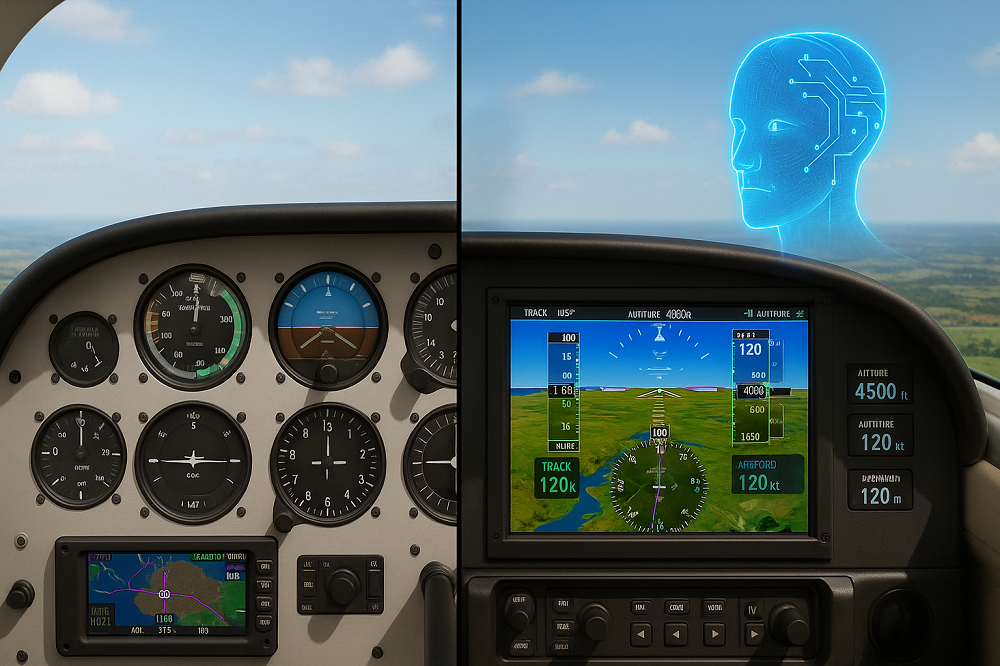Artificial intelligence (AI) is transforming industries across the globe, and aviation is no exception. From flight planning to maintenance diagnostics and air traffic control, AI is making its presence known in ways that improve safety, efficiency, and decision-making. For student pilots and new private pilots, understanding AI’s role in the cockpit and beyond is becoming an essential part of modern aviation awareness.
You might not be flying a fully autonomous airplane anytime soon, but AI is already working behind the scenes to enhance the flight experience. In this article, we will explore how AI is being used in aviation today, how it might affect the future of flying, and what you should know to stay informed and prepared as a modern aviator.
What Is Artificial Intelligence?
Artificial intelligence refers to computer systems that perform tasks normally requiring human intelligence. This includes:
- Learning from data
- Solving problems
- Recognizing patterns
- Making decisions
- Understanding language
- Interacting with people or systems
AI can be programmed with fixed rules (called “narrow AI”) or trained to adapt based on experience and input (machine learning). In aviation, both forms are being used to assist with routine and complex tasks, often faster and with fewer errors than a human alone.
AI Applications in Aviation Today
AI is already making a difference in several areas of aviation. Here’s how it is being used across the industry and what it means for general aviation pilots.
1. Flight Planning and Weather Prediction
AI helps generate more accurate weather models and smarter flight routes. Tools powered by machine learning can:
- Predict turbulence and icing with greater accuracy
- Suggest fuel-efficient altitudes and headings
- Identify safer routing options around storms and restricted areas
- Help EFB apps like ForeFlight recommend optimal departure times
By analyzing large datasets that include current conditions, forecasts, and past flight data, AI enhances preflight planning, allowing pilots to make better-informed decisions.
2. Pilot Training and Flight Simulators
AI is being used in modern flight simulators and training platforms to:
- Provide adaptive learning tailored to each student’s progress
- Offer real-time feedback and suggestions during simulator sessions
- Analyze flight performance and flag areas for improvement
- Simulate ATC responses and traffic scenarios more realistically
For student pilots, this means smarter, more personalized instruction and better opportunities to improve without additional flight time. Some training systems even use AI to predict when a student is ready for a checkride or needs more review.
3. Maintenance and Diagnostics
In aviation maintenance, AI helps reduce downtime and prevent failures through predictive diagnostics. AI systems can:
- Monitor engine and aircraft sensor data for early warning signs
- Predict when a part is likely to fail based on usage and historical patterns
- Help maintenance crews prioritize inspections and repairs
For private aircraft owners and rental operators, this can improve reliability, reduce costs, and enhance flight safety.
4. Air Traffic Control and Airspace Management
AI is assisting air traffic controllers by:
- Predicting aircraft movements and potential conflicts
- Helping optimize sequencing and separation in busy airspace
- Improving rerouting strategies during congestion or weather events
In the future, AI may help with unmanned traffic management (UTM) systems for drones and enable safer integration of multiple types of aircraft in shared airspace.
5. Voice Recognition and ATC Support
Some systems are now testing voice recognition AI that can:
- Transcribe ATC communications in real time
- Alert pilots to missed calls or incorrect readbacks
- Interpret pilot requests and issue standard responses
While not yet widely available in general aviation, this technology could assist student pilots in improving their communication skills and reducing radio anxiety during busy flights.
6. Autonomous and Semi-Autonomous Flight Systems
Autonomous flight is one of the most publicized applications of AI in aviation. Companies like Xwing and Reliable Robotics are testing cargo aircraft that can fly without onboard pilots, using AI for decision-making and navigation.
In general aviation, systems like Garmin Autoland already use AI-driven logic to land an airplane safely if the pilot becomes incapacitated. This feature, available in some Cirrus and Piper aircraft, requires no input from the pilot and can navigate to the nearest suitable airport, communicate with ATC, and land automatically.
While full autonomy for personal flying is still years away, these technologies show how AI can step in when humans are unable to act.
What This Means for Student and Private Pilots
You might be wondering: how does all of this affect me right now? Here are a few key points for today’s pilots:
1. Your Role Is Changing, Not Disappearing
AI will not replace pilots, but it will change how you work. You’ll still be responsible for:
- Managing the flight
- Making final decisions
- Understanding systems and procedures
- Communicating with ATC
- Ensuring safety
Your role may shift toward more systems management, with AI providing support and suggestions.
2. Learn the Technology Early
As a student pilot, learning how to interact with digital tools and AI-assisted systems gives you an advantage. You should:
- Understand what AI-driven tools your EFB offers
- Know how to use synthetic vision, traffic displays, and auto-routing
- Practice using automation without becoming dependent on it
Staying current with updates and learning how to manage failure modes is critical.
3. Focus on Core Skills First
Technology is powerful, but it should not come at the cost of basic skills. New pilots should:
- Practice hand flying regularly
- Learn to navigate without GPS
- Use paper charts as a backup
- Know how to handle systems malfunctions
AI is a supplement, not a substitute, for airmanship.
4. Expect AI in Checkrides and Training
Some designated pilot examiners and instructors are already asking questions about automation use and decision-making with AI tools. You might be expected to explain:
- How to use weather prediction features in your EFB
- What your autopilot is capable of
- What backup procedures you would use if technology fails
Demonstrating understanding and judgment is just as important as knowing how to push the buttons.
Benefits and Risks of AI in Aviation
Let’s review the pros and cons of using AI as a tool in general aviation:
Benefits:
- Improved safety through better predictions and alerts
- More efficient routing and fuel planning
- Real-time risk assessments and decision support
- Enhanced situational awareness
- Reduced pilot workload
Risks:
- Overreliance on automation
- Lack of understanding of how systems work
- Decreased hand-flying skills
- System errors or misinterpretations
- Potential cybersecurity vulnerabilities
The key to safe AI use is awareness, education, and balance. Pilots who understand the tools and know when to trust them, and when not to, will benefit the most.
The Future of AI in General Aviation
Here’s what we may see in the next 10 to 20 years:
- Personal aircraft with full emergency automation
- AI copilots that assist with tasks and offer real-time coaching
- Integrated traffic, terrain, and weather prediction systems
- Voice-command flight planning and autopilot control
- More remote-controlled and autonomous cargo and training aircraft
As a private pilot, your future flights might include monitoring an AI copilot, adjusting its decisions, or handing over control for a portion of the trip. Your understanding of both flight fundamentals and smart systems will be the foundation of safe flying.
Final Thoughts
The rise of AI in aviation is not just about robots flying airplanes. It is about giving human pilots better tools to make safer, smarter decisions. For student pilots and new private pilots, this means learning how to fly the airplane, and how to work with the systems that support it.
By combining strong foundational skills with an openness to new technology, you will be well-prepared for the future of aviation. AI will continue to grow, and the best pilots will be the ones who know how to use it wisely.
Sources
– FAA: *Artificial Intelligence in Aviation Advisory Committee*
– NASA: *AI and Autonomous Systems in Aviation*
– Garmin: *Autoland and Emergency Automation*
– ForeFlight: *AI-Powered Planning Tools*
– AOPA: *How AI Is Changing the Way We Fly*
Recent Posts
FAA MOSAIC Final Rule: What Pilots, Manufacturers, and the Aviation Community Need to Know
Learn how the FAA’s MOSAIC final rule revolutionizes Light-Sport Aircraft certification, expands Sport Pilot privileges, and reshapes general aviation. See what’s changing, when it takes effect,...
Student Pilot Insurance: Essential Coverage for Aspiring Flyers
Discover how student pilot insurance can protect your flying dreams. Get expert tips and coverage options to ensure your safety and peace of mind.


